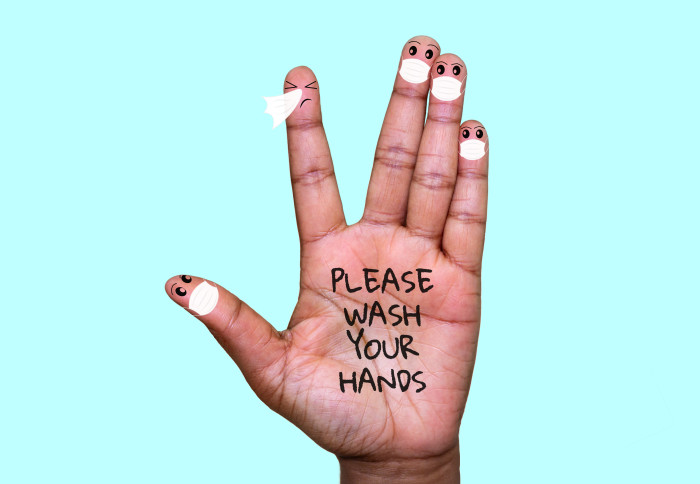

How can public health messaging cut through the flood of information and encourage responsible behaviour?
Dr Talya Porat of Imperial’s Dyson School of Design Engineering is an expert in human factors engineering – a field that focuses on how systems work with fallible, malleable humans at their helm.
She researches human interaction with medical systems and public health messaging, focusing on how healthcare initiatives impact our decision-making and patient outcomes.
In a new paper, published in Frontiers in Public Health, Dr Porat looks at behavioural change and adherence to preventative measures for infection during the COVID-19 pandemic, at a time where getting public health messaging right is more important than ever before.
Caroline Brogan spoke to her about the paper.
Why is it so important to provide clear, empowering messaging right now?
What we’re seeing right now is an ‘infodemic’ - an over-abundance of information. Dr Talya Porat Dyson School of Design Engineering
Amidst the COVID-19 pandemic, we are all being asked to drastically change how we interact with each other and our environment for the sake of public health. Evidence-based infection control measures like social distancing, hand-washing, and face-covering, are a core part of this – but for them to work, we all must do our bit. This is particularly important as it becomes clearer that these measures may be needed for a long period of time, and not for a few weeks as was initially projected.
However, what we’re seeing right now is an ‘infodemic’ - an over-abundance of information which can make it hard for people to find trustworthy and reliable guidance to make informed decisions.
We wanted to provide guidelines to help policy makers, governments and healthcare bodies to cut through the noise and deliver effective messaging to help people stick to preventative measures for a long period of time, while fostering their well-being.
How did you come up with the guidelines?
We used concepts and methods from psychology, philosophy and human-computer interaction to better understand human behaviours and motivations. When we understand the basic human psychological needs – self-reliance (autonomy), feeling capable (competence), and solidarity and a feeling of belonging (relatedness) - we can create guidance that chimes with those needs.
Although these factors have not been fully tested against current messaging during the pandemic, we looked at studies on these factors throughout the scientific literature and compared them to current pandemic messaging around the world.
What did you find and is there anything we can do better?
Helping people to understand the reasons behind messages, instead of using pressures like punishment or reward, is more likely to get results. Dr Talya Porat Dyson School of Design Engineering
We found that one of the most important things to support sustainable, lasting changes in behaviour is to support people’s autonomy. Ideally people would adhere to the current restrictions because they believe it is important and not because they are afraid to 'get caught’. We can do this by helping them to understand, endorse, and identify with why some behaviours are important, and why others are harmful.
Helping people to understand the reasons behind messages, instead of using pressures like punishment or reward, is more likely to get results. In fact, using negative motivations like punishment and reward may work in the short term but damage the autonomy and health of citizens in the longer term. This is because they often reflect self-serving motives, lack of transparency, and limited information sharing.
In addition:
- Allowing a degree of choice – like including information on what people can do (exercising, ordering food) as well as what they can’t.
- Engaging different audiences and understanding their specific circumstances and needs is critical in designing interventions that will be inclusive and tailored to unique circumstances.
- Emphasising desired behaviours as a collective effort rather than an ‘us versus them’ mentality.
- Acknowledging uncertainty and providing regular updates, which contribute to transparency.
Can you give me an example?
During this pandemic, one of the most inconsistent and ambiguous messages to the public was about face-covering: whether people should wear them and if so, which type and under what circumstances. While borne from an initial lack of scientific evidence, the messaging could certainly have been clearer while we awaited consensus on whether face masks were effective.
Our results suggest local governments and health authorities should provide rapid, clear, consistent, and repetitive messages with meaningful rationale and reflecting personal value. For example the Czech Republic Masks4All campaign of “Your mask protects me, my mask protects you” was very effective.
How do you hope these guidelines will contribute to the pandemic response?
Well researched, designed and delivered health communication that starts by fostering people’s well-being has the potential to cut through the noise and promote effective and sustainable behaviour change. Dr Talya Porat Dyson School of Design Engineering
The factors affecting the pandemic outcomes in different countries are complex, and their medium and long-term social, psychological, and economic costs are far from being understood. However, we do believe that well researched, designed and delivered health communication that starts by fostering people’s well-being has the potential to cut through the noise and promote effective and sustainable behaviour change.
We hope our findings can provide a starting point for developing a concrete public health communications strategy in such pandemics.
Our proposed guidelines are based on evidence from other domains and will need to be validated in the context of public health communication during such pandemics. Likewise, as evidence on public health messaging in this pandemic emerges, we plan to perform robust analyses of the best strategies for public cooperation and communication while preparing for future health crises.
We hope that by giving people clearer and better public health messages, we can encourage them to make important, lasting behavioural changes that can reduce the impact of the pandemic - ultimately protecting public health and saving lives.
“Public Health and Risk Communication During COVID-19—Enhancing Psychological Needs to Promote Sustainable Behavior Change” by Talya Porat et al., published 27 October 2020 in Frontiers in Public Health.
Article text (excluding photos or graphics) available under an Attribution-NonCommercial-ShareAlike Creative Commons license.
Photos and graphics subject to third party copyright used with permission or © Imperial College London.
Reporter

Caroline Brogan
Communications Division

Contact details
Email: press.office@imperial.ac.uk
Show all stories by this author




Leave a comment
Your comment may be published, displaying your name as you provide it, unless you request otherwise. Your contact details will never be published.